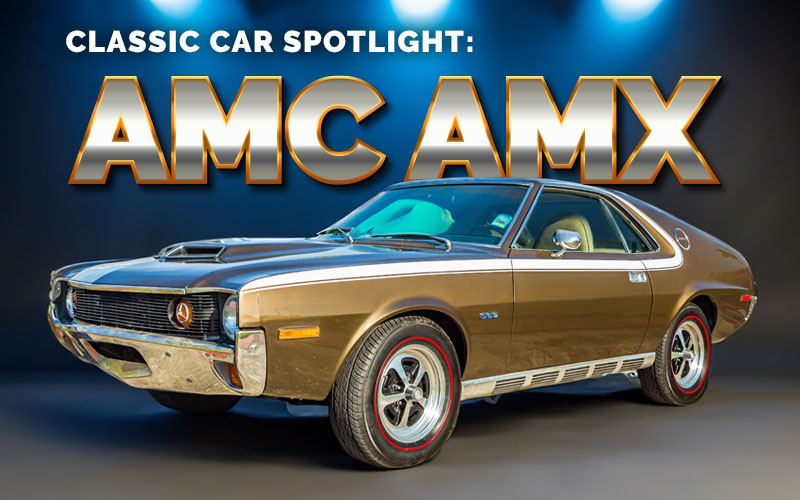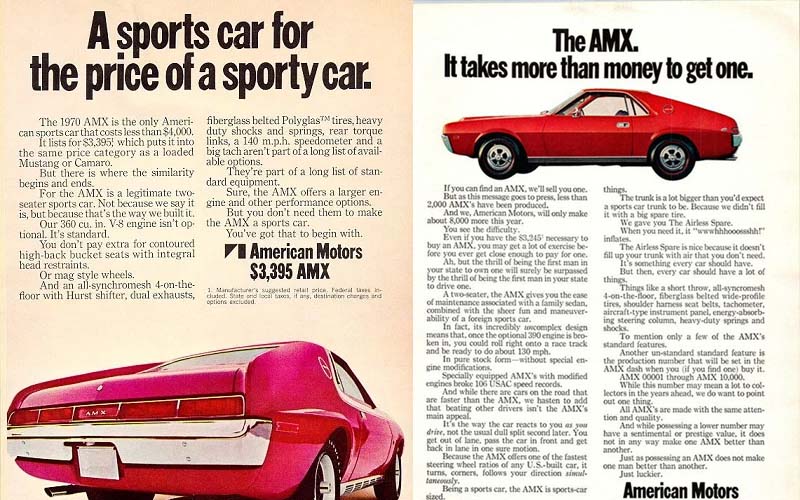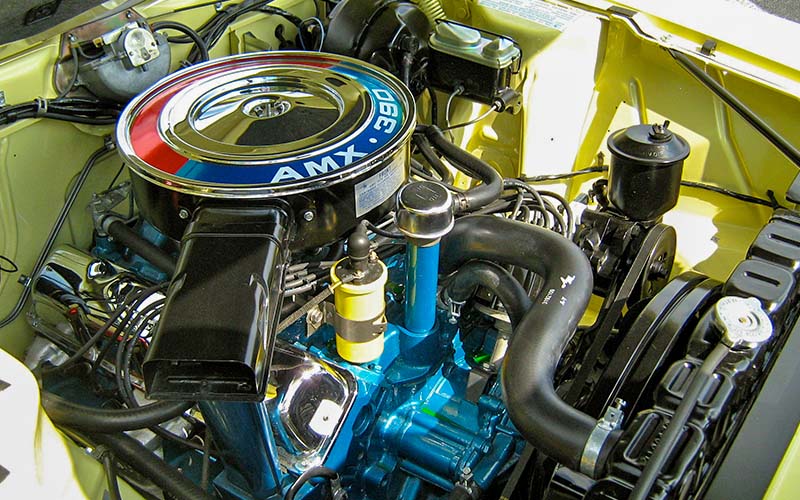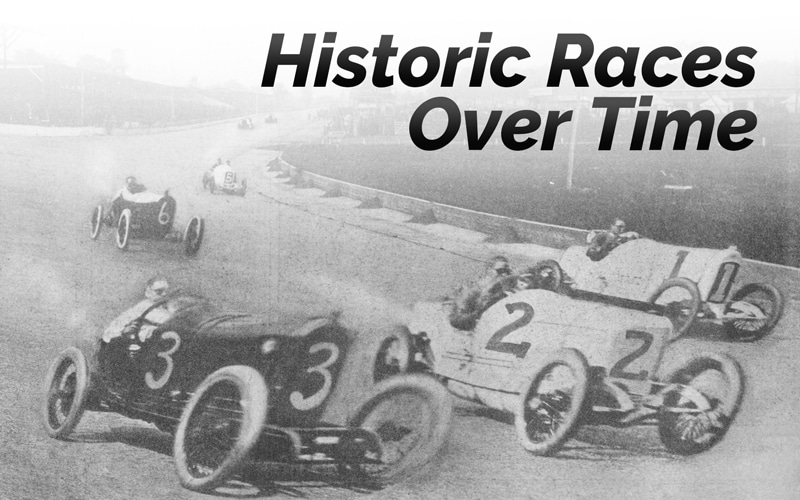At American Collectors Insurance, we don’t stop at offering great rates on great policies. Our TreasureGuard policy provides broader protection and greater flexibility. Receive a classic car insurance quote in minutes to see how you can save.

AMX: Muscle Meets Sports
By the mid to late 60s, the American automotive industry was fully embracing the growing muscle car trend. With the rise of the biggest names like Ford Mustang, Chevrolet Corvette and Camaro, and Pontiac’s GTO, America’s car manufactures were itching to throw their hat into the ring of American Muscle.
Seeing this trend in the mid 1960s, American Motors Corporation (AMC) wasn’t content with simply joining the muscle car club—they wanted to make a statement and shed the company’s “economy car” image and appeal to a more youthful, performance-oriented market. And that they did just that with the introduction of the impressive AMC AMX. The AMX name originates from the “American Motors experimental” code used on a concept vehicle and then on two prototypes, a fiberglass two-seat “AMX” and a four-seat “AMX II”.

AMC Javelin and AMX
The AMC AMX officially hit the public automotive scene on February 24th, 1968, only five months after the AMC Javelin, the vehicle AMC based the AMX model on. However this model had a shorter wheelbase and deletion of the rear seat. In addition, the AMX’s rear quarter windows remained fixed, making it a coupe, while the Javelin remained a true two-door hardtop. With its sleek lines, muscular stance, and aggressive front grille— the AMX came to the scene with an aggressive look that stood out in a sea of look-alike vehicles, capturing the imagination of car enthusiasts and setting the stage for an unforgettable chapter in automotive history.

But the AMX was more than just a pretty face. Underneath its captivating exterior, it packed a punch in the performance department. A range of engine options were available, each delivering a thrilling driving experience. The legendary AMX 390, with its 6.4-liter V8 engine, was a force to be reckoned with, producing an impressive amount of horsepower and torque that could propel you down the road with exhilarating speed. This two-seat style was officially one of just two American-built two-seaters. The AMX was in direct competition with the one-inch (2.5 cm) longer wheelbase Chevrolet Corvette, for substantially less money. It was also the only American-built, steel-bodied two-seater of its time, the first since the 1955–1957 Ford Thunderbird. The price difference between its competitors allowed AMC to promote the AMX as “the only American sports car that costs less than $3500.”

Despite the affordable price point, the AMX didn’t slack in the performance department. It was fitted with the standard high-compression 290 cu in (4.8 L) or optional 390 cu in (6.4 L) AMC V8 engine. In January 1968, a month before the public release, two specially prepared AMXs set 106 world speed and endurance records at Goodyear’s track in Texas. The AMX was also brought to the Bonneville Speedway, reaching 189 mph (304 km/h) in a United States Auto Club (USAC) sanctioned run, as well as an unofficial run of over 200 mph (322 km/h). This gave the car community something to buzz about before the official launch.
Even with these impressive performances, low price point and enthusiastic initial reception by automotive media and enthusiasts, sales didn’t thrive as well as AMC had hoped. After three model years, the two-seat version was officially discontinued. Though AMC ultimately chose to discontinue the model, the AMX was a statement of AMC’s commitment to producing exciting and distinctive vehicles that would capture the hearts and imaginations of those seeking a unique driving experience. It was a daring move that solidified AMC’s reputation as a company willing to push boundaries and make a lasting impact in the automotive world.

Outside of the United States, a total of 24 right hand drive 1969 model year AMXs were hand assembled in Australia under license by Australian Motor Industries (AMI). They were produced under the name Rambler AMX as AMI produced the Rambler range of cars since October 1960. Standing out from the U.S. models, the RHD Australian AMXs included different outside rear-view mirrors, and black vinyl trim inside the “AMX” circle logo on the C-pillars.
The limited production numbers of the AMX caused by the model only being produced from 1968-1970 combined with its distinctive design make it a sought-after collector vehicle, with passionate enthusiasts vying to own and restore these automotive treasures. This exclusivity adds to the car’s allure and scarcity, making it a prized possession for collectors who appreciate its uniqueness. The AMX’s popularity continues to grow as more people appreciate its significance in automotive history and its timeless appeal.
Within the AMX lineup, there are also specific models that are considered even rarer. For instance, the AMX/3 prototype, a mid-engine concept car developed in collaboration with Italian automaker Bizzarrini, holds a legendary status among enthusiasts. Only a handful of these prototypes were ever built, making them extremely rare and highly sought after by collectors. Or the powerful AMX SS (Super Stock)— which was specially designed for the racetrack touting a 390-engine equipped with twin Holley carburetors and 12.3:1 compression-ratio cylinder heads, plus aftermarket Doug’s headers and exhaust system, and drag slick tires to maximize quarter-mile performance.

The AMC AMX represents a bold and daring chapter in automotive history. With its rebellious spirit, high-performance capabilities, and distinctive design, the AMX continues to captivate the hearts of classic car enthusiasts around the world. Its legacy as an iconic American muscle car is firmly established, and its impact on automotive culture remains undeniable. So, next time you catch a glimpse of an AMC AMX on the road or at a car show, take a moment to appreciate the unique blend of power, style, and innovation that has made this legendary icon an eternal favorite among automotive connoisseurs.

As time goes on, the collectability of the AMC AMX continues to rise, as more enthusiasts recognize its historical significance and distinctive design. Whether it’s the distinctive silhouette, the rumble of its V8 engine, or the nostalgia it evokes, the AMC AMX stands as a testament to the creativity, craftsmanship, and passion that went into its creation. The rarity and exclusivity associated with these iconic muscle cars make them sought after at classic car auctions, where they often attract considerable attention and high bids from collectors looking to add an AMC AMX to their prized collection.

One thing is clear, the legacy of the AMC AMX will live on for generations to come, serving as a testament to its timeless charm and enduring value. Preserving and maintaining the condition of an AMC AMX is crucial for maintaining its value and collectability. Restoring these classic cars to their original specifications requires meticulous attention to detail and access to authentic parts. Fortunately, there is a passionate network of specialists and dedicated AMC enthusiasts who can provide invaluable expertise and resources for restoration projects.

Leave A Comment